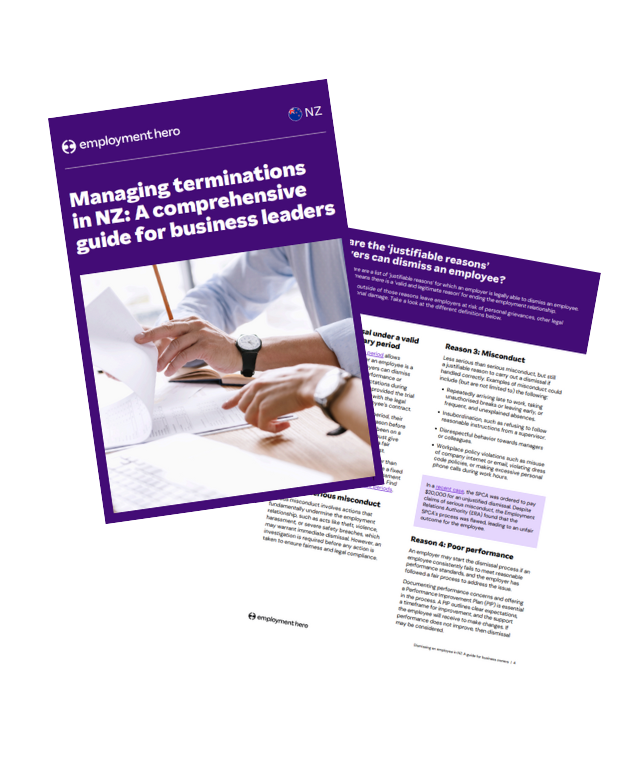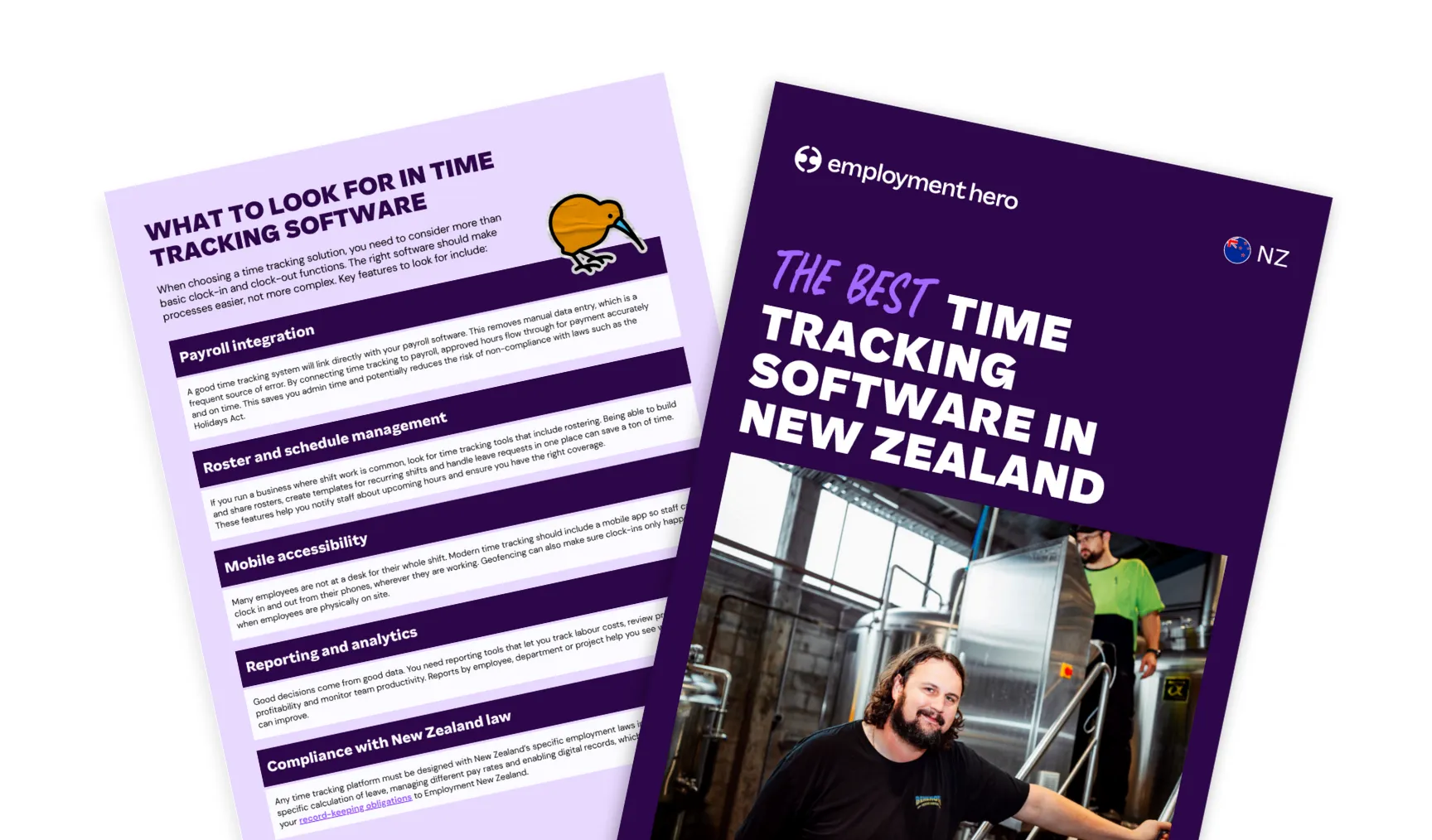Managing terminations in NZ: A comprehensive guide for business leaders
Published
Managing terminations in NZ: A comprehensive guide for business leaders
Published
2 min read

If you’ve been an employer for some time, you’ll know that dismissing an employee is not a simple task in New Zealand. New Zealand employment law tends to favour the employee in many cases, and that can make it difficult for employers with genuine concerns to take action.
Even if it seems like a clear-cut case from your perspective, it may not be as straightforward in the eyes of the law. Plus, employment law is always evolving, so it can be tough to keep up.
In this guide, we’ll outline the process for termination, including when you can and can’t legally dismiss an employee, plus other legal considerations to be aware of.
Download the guide today.
Disclaimer: The information in this guide is current as at 3 April 2025 and has been prepared by Employment Hero Pty Ltd (ABN 11 160 047 709) and its related bodies corporate (Employment Hero). The views expressed in this guide are general information only, are provided in good faith to assist employers and their employees, and should not be relied on as professional advice. The Information is based on data supplied by third parties. While such data is believed to be accurate, it has not been independently verified and no warranties are given that it is complete, accurate, up to date or fit for the purpose for which it is required. Employment Hero does not accept responsibility for any inaccuracy in such data and is not liable for any loss or damages arising either directly or indirectly as a result of reliance on, use of or inability to use any information provided in this guide. You should undertake your own research and to seek professional advice before making any decisions or relying on the information in this guide.

What the law says
In New Zealand, the primary legislation governing employee dismissals is the Employment Relations Act 2000.
- This Act sets out the fundamental principles of good faith and fair process that employers must adhere to when dismissing an employee.
- It establishes the framework for personal grievances, which employees can raise if they believe they have been unjustifiably dismissed.
- It addresses various aspects of employment relationships, including employment agreements, dispute resolution, and union rights.
Good faith and fair process under the Act
The principle of ‘good faith’ and fair process are two major tenets that run throughout the Act.
Good faith stipulates that both employers and employees are required to deal with each other in good faith, meaning they must be honest, open, and fair in their dealings.
Related to good faith, fair process means employers must follow a fair and reasonable process when carrying out a dismissal.
In relation to dismissals, this typically looks like:
- Clearly communicating with the employee the expectations for their role, and communicating clearly if they are not meeting those expectations.
- Clearly communicating with the employee the reasons for a potential dismissal.
- Giving the employee enough time and opportunity to respond to, and rectify those concerns.
- Considering the employee’s response before making any final decisions.
Valid reasons to end an employees employment
Under the Act, there are a list of ‘justifiable reasons’ for which an employer is legally able to dismiss an employee. Justifiable reason means there is a ‘valid and legitimate reason’ for ending the employment relationship.
Dismissals that fall outside of those reasons leave employers at risk of personal grievances, other legal action and reputational damage. Take a look at the different definitions below.
Reason 1: Dismissal under a valid trial or probationary period
A valid trial or probationary period allows employers to assess whether an employee is a suitable fit for the role. Employers can dismiss someone if the employee’s performance or behaviour does not meet expectations during the trial or probationary period, provided the trial or probationary period complies with the legal requirements set out in the employee’s contract.
If an employee has been on a trial period, their employer does not have to give a reason before dismissing them. If an employee has been on a probationary period, their employer must give them a good reason for dismissal and a fair opportunity to resolve any problems first.
Heads up: a trial period cannot last longer than 90 days. Probationary periods do not have a fixed time limit so can be used for a longer assessment period if the employee and employer agree. Find out more about trials and probationary periods.
Reason 2: Serious misconduct
Serious misconduct involves actions that fundamentally undermine the employment relationship, such as acts like theft, violence, harassment, or severe safety breaches, which may warrant immediate dismissal. However, an investigation is required before any action is taken to ensure fairness and legal compliance.
In a recent case, the SPCA was ordered to pay $20,000 for an unjustified dismissal. Despite claims of serious misconduct, the Employment Relations Authority (ERA) found that the SPCA’s process was flawed, leading to an unfair outcome for the employee.
Reason 3: Misconduct
Less serious than serious misconduct, but still a justifiable reason to carry out a dismissal if handled correctly. Examples of misconduct could include (but are not limited to) the following:
- Repeatedly arriving late to work, taking unauthorised breaks or leaving early, or frequent, and unexplained absences.
- Insubordination, such as refusing to follow reasonable instructions from a supervisor.
- Disrespectful behavior towards managers or colleagues.
- Workplace policy violations such as misuse of company internet or email, violating dress code policies, or making excessive personal phone calls during work hours.
Reason 4: Poor performance issues
An employer may start the dismissal process if an employee consistently fails to meet reasonable performance standards, and the employer has followed a fair process to address the issue.
Documenting performance concerns and offering a Performance Improvement Plan (PIP) is essential in the process. A PIP outlines clear expectations, a timeframe for improvement, and the support the employee will receive to make changes. If performance does not improve, then dismissal may be considered.
Reason 5: Redundancy
When an employee’s position is no longer required due to business restructuring or other legitimate reasons, an employer may make an employee’s position redundant, and therefore dismiss the employee.
However, dismissing someone through redundancy requires a fair process centered on genuine business reasons. These can include things like financial difficulties or technological changes, but not personal performance. Redundancy dismissals also require thorough consultation with the employee – which we explore in the guide.
Does this law cover all employee types?
All employee types – full-time, part-time, fixed-term and casual – are covered by the Employment Relations Act. However, casual and fixed-term employment arrangements often allow for shorter notice periods if the employer dismisses the employee.
Employers should follow the same principles of good faith and fair process with all employees, but pay special attention to their contracts in terms of their necessary termination notice period.
Key considerations for dismissing employees
Dismissals based on performance or misconduct
Dismissing an employee should be the last resort for employers. Before beginning any dismissal processes, the employer must undertake steps to address the performance issues with the employee. If the employee has not made the necessary improvements within an agreed timeframe, only then can the employer consider moving to the dismissal process.
Dismissals based on serious misconduct
For dismissal procedures based on serious misconduct, employers must still carry out a fair investigation and disciplinary process before actioning a dismissal. However, if, after a fair investigation and disciplinary process, they are found guilty of serious misconduct, they may be ‘summarily dismissed’.
‘Summary dismissal’ is when an employee is dismissed without notice. This means they are not given the opportunity to work out their notice period and are not paid out for the notice period.
Key steps for the dismissal process
1. Clearly document the reason for dismissal
Keep detailed records outlining the reasons for dismissal, including performance issues, misconduct, or redundancy. Gather evidence such as written warnings, performance reviews, or incident reports.
2. Meet with the employee to discuss concerns and issues
Schedule a private meeting to address concerns openly and professionally. Clearly explain the issues, referencing previous warnings or documented incidents. Allow the employee to bring a support person. Maintain a neutral tone and ensure the conversation follows a fair and constructive process.
3. Provide the employee with an opportunity to respond
Give the employee a chance to explain their side, provide context, or dispute any claims. Carefully consider their response before making a final decision. This step demonstrates procedural fairness and helps reduce the risk of unjustified dismissal claims.
4. Hold a meeting to outline final steps
If dismissal is confirmed, meet with the employee to explain the final steps. Discuss the notice period (if applicable*=) last working day, and how company property or equipment should be returned. Provide written confirmation of dismissal, including any obligations or entitlements.
5. Finalise any outstanding pay or leave entitlements
Ensure the employee receives their final wages, including unused holiday pay or outstanding bonuses if applicable. Provide a final payslip detailing all payments. If applicable, discuss KiwiSaver contributions or tax obligations. Issue a written confirmation of final pay to maintain transparency.
How to dismiss an employee through redundancy
The same principles of good faith and fair process apply to dismissing employees through redundancy. However, there are unique steps you need to take for a redundancy dismissal versus a performance or misconduct-based dismissal.
1. Create a business case
First, employers need to create a clear business case that proposes structural changes to the business. Those structural changes must be based on the needs of the business – for example, cost-cutting, changes to products or services, revenue loss or another valid business reason.
2. Consult with employees
Employers must then consult with affected employees, genuinely considering their feedback. A crucial step is exploring redeployment options within the company – employers must take time to consider whether employees can be redeployed into another role as part of this process.
3. Provide adequate, formal notice based on the employment contract
If redeployment is not possible and redundancy is unavoidable, the employer needs to provide formal notice, following the employment agreement’s terms or giving reasonable notice.
4. Finalise offboarding for redundant employees
The employer must pay all owed entitlements such as outstanding pay or leave balances to the employee. Redundancy pay is only mandatory if specified in the employment agreement – but it’s not a legal requirement. Finally, it’s best practice to offer support to affected employees, whether through an EAP service or by supporting them to find a new job.
What happens if an employer “forces” an employee to resign?
If an employer makes an employee’s working conditions so intolerable that a reasonable person would feel compelled to resign, this is known as constructive dismissal. The employee then has grounds to submit a personal grievance on the basis of constructive dismissal, which may come with significant financial penalties. The employee’s resignation is then treated, in legal terms, as a dismissal.
Given employers can be at risk of legal action even if they don’t explicitly dismiss an employee, it’s important to make sure you’re always acting in good faith. Any actions taken by the employer which could be deemed ‘hostile’ or that create an untenable working environment may be considered grounds for constructive dismissal, which may leave them vulnerable to personal grievances.
One bad apple spoiling the bunch? We’ve got your back.
Dismissing an employee in NZ is clearly a complex process, filled with room for error. For employers, understanding the proper process for dealing with misconduct, poor performance and redundancies is essential to protecting the interests of the business.
But… going it alone can be overwhelming and confusing – not to mention financially draining.
Fortunately, our Employment Operating System provides built-in, customisable training modules you can assign to leaders in just a few clicks. Plus, built-in performance management software empowers managers to keep their team on track. Assign KPIs and track progress against them, instantly schedule 1:1s, performance reviews and even peer-to-peer reviews to get a detailed picture of your team’s performance.
What’s more, you can access our dedicated HR Advisory service whenever the need arises. Tensions brewing in the office? Not sure if there’s grounds for dismissal? Give our experts a ring and we’ll point you in the right direction.
Register for the checklist
Related Resources
-
 Read more: Best time tracking software for NZ businesses
Read more: Best time tracking software for NZ businessesBest time tracking software for NZ businesses
Discover the best time tracking software for NZ businesses. Compare tools, find the right fit, and make time tracking simple…
-
 Read more: HR Managers: Don’t just survive the festive season, master it
Read more: HR Managers: Don’t just survive the festive season, master itHR Managers: Don’t just survive the festive season, master it
Make year-end easier: manage leave, payroll, parties and shutdowns with confidence. Get practical tips for NZ SMEs. Download the free…
-
 Read more: Outsourcing payroll in New Zealand: Guide for employers
Read more: Outsourcing payroll in New Zealand: Guide for employersOutsourcing payroll in New Zealand: Guide for employers
Learn how payroll outsourcing works in NZ, its benefits and risks, and how Employment Hero NZ makes it simpler and…





















